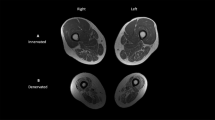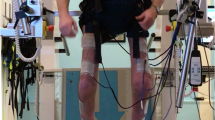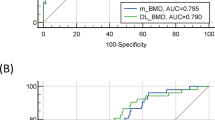Abstract
Design:
Longitudinal prospective case series.
Objective:
To evaluate the impact of early introduction postspinal cord injury (SCI) of twice-weekly body-weight supported treadmill training (BWSTT) on muscle and bone.
Setting:
Centre for Health Promotion and Rehabilitation, McMaster University, Canada.
Methods:
Five individuals who had sustained traumatic SCI within 2–6 months participated in the study. Bone mineral densities (BMD) of proximal femur, distal femur, proximal tibia and lumbar spine were measured before and after training, as well as muscle cross-sectional area (CSA), BMD and bone geometry at mid-femur and proximal tibia. Serum osteocalcin and urinary deoxypyridinoline were measured at baseline, and after 24 and 48 sessions of training.
Results:
All participants experienced increased muscle CSAs, ranging from 3.8 to 56.9%. Reductions in BMD were evident in all participants at almost all lower limb sites after training, ranging in magnitude from −1.2 to −26.7%. Lumbar spine BMD changes ranged from 0.2 to −7.4%. No consistent changes were observed in bone geometry. BWSTT did not alter the expected pattern of change in bone biochemical markers over time. The individual with the greatest improvement in ambulatory ability demonstrated the smallest reduction in lower limb BMD. Conversely, the individual who completed the fewest BWSTT sessions demonstrated the greatest reductions in BMD.
Conclusions:
Twice-weekly BWSTT appeared to partially reverse muscle atrophy after SCI, but did not prevent bone loss. Larger, controlled trials should evaluate whether relative preservation of bone loss occurs with regular BWSTT following acute SCI.
Sponsorship:
Ontario Neurotrauma Foundation.
Similar content being viewed by others
Log in or create a free account to read this content
Gain free access to this article, as well as selected content from this journal and more on nature.com
or
References
Burnham R, Martin T, Stein R, Bell G, MacLean I, Steadward R . Skeletal muscle fibre type transformation following spinal cord injury. Spinal Cord 1997; 35: 86–91.
Castro MJ, Apple Jr DF, Staron RS, Campos GE, Dudley GA . Influence of complete spinal cord injury on skeletal muscle within 6 mo of injury. J Appl Physiol 1999; 86: 350–358.
Castro MJ, Apple Jr DF, Hillegass EA, Dudley GA . Influence of complete spinal cord injury on skeletal muscle cross-sectional area within the first 6 months of injury. Eur J Appl Physiol Occup Physiol 1999; 80: 373–378.
Garland DE et al. Osteoporosis after spinal cord injury. J Orthopaed Res 1992; 10: 371–378.
de Bruin ED, Vanwanseele B, Dambacher MA, Dietz V, Stussi E . Long-term changes in the tibia and radius bone mineral density following spinal cord injury. Spinal Cord 2005; 43: 96–101.
Sabo D, Blaich S, Wenz W, Hohmann M, Loew M, Gerner HJ . Osteoporosis in patients with paralysis after spinal cord injury. A cross sectional study in 46 male patients with dual-energy X-ray absorptiometry. Arch Orthop Trauma Surg 2001; 121: 75–78.
Szollar SM, Martin EM, Parthemore JG, Sartoris DJ, Deftos LJ . Densitometric patterns of spinal cord injury associated bone loss. Spinal Cord 1997; 35: 374–382.
Comarr AE, Hutchinson RH, Bors E . Extremity fractures of patients with spinal cord injuries. Am J Surg 1962; 103: 732–739.
Nottage WM . A review of long-bone fractures in patients with spinal cord injuries. Clin Orthop 1981; (155): 65–70.
Ragnarsson KT, Sell GH . Lower extremity fractures after spinal cord injury: a retrospective study. Arch Phys Med Rehabil 1981; 62: 418–423.
Vestergaard P, Krogh K, Rejnmark L, Mosekilde L . Fracture rates and risk factors for fractures in patients with spinal cord injury. Spinal Cord 1998; 36: 790–796.
Freehafer AA, Hazel CM, Becker CL . Lower extremity fractures in patients with spinal cord injury. Paraplegia 1981; 19: 367–372.
Baldi JC, Jackson RD, Moraille R, Mysiw WJ . Muscle atrophy is prevented in patients with acute spinal cord injury using functional electrical stimulation. Spinal Cord 1998; 36: 463–469.
Belanger M, Stein RB, Wheeler GD, Gordon T, Leduc B . Electrical stimulation: can it increase muscle strength and reverse osteopenia in spinal cord injured individuals? Arch Phys Med Rehabil 2000; 81: 1090–1098.
Dudley GA, Castro MJ, Rogers S, Apple Jr DF . A simple means of increasing muscle size after spinal cord injury: a pilot study. Eur J Appl Physiol Occup Physiol 1999; 80: 394–396.
Pacy PJ, Hesp R, Halliday DA, Katz D, Cameron G, Reeve J . Muscle and bone in paraplegic patients, and the effect of functional electrical stimulation. Clin Sci (London) 1988; 75: 481–487.
Scremin AM, Kurta L, Gentili A, Wiseman B, Perell K, Kunkel C et al. Increasing muscle mass in spinal cord injured persons with a functional electrical stimulation exercise program. Arch Phys Med Rehabil 1999; 80: 1531–1536.
Eser P, de Bruin ED, Telley I, Lechner HE, Knecht H, Stussi E . Effect of electrical stimulation-induced cycling on bone mineral density in spinal cord-injured patients. Eur J Clin Invest 2003; 33: 412–419.
Hangartner TN, Rodgers MM, Glaser RM, Barre PS . Tibial bone density loss in spinal cord injured patients: effects of FES exercise. J Rehabil Res Dev 1994; 31: 50–61.
Hicks AL et al. Long-term body-weight-supported treadmill training and subsequent follow-up in persons with chronic SCI: effects on functional walking ability and measures of subjective well-being. Spinal Cord 2005; 43: 291–298.
Hicks AL, McCartney N, Phillips S, Smith M, Radforth L . The effects of long-term body-weight supported treadmill training on walking ability in persons with incomplete spinal cord injury. Can J Appl Physiol 2002; 27: S21.
Wernig A, Muller S, Nanassy A, Cagol E . Laufband therapy based on ‘rules of spinal locomotion’ is effective in spinal cord injured persons [published erratum appears in Eur J Neurosci 1995 Jun 1; 7(6): 1429]. Eur J Neurosci 1995; 7: 823–829.
de Bruin ED, Frey-Rindova P, Herzog RE, Dietz V, Dambacher MA, Stussi E . Changes of tibia bone properties after spinal cord injury: effects of early intervention. Arch Phys Med Rehabil 1999; 80: 214–220.
Wernig A, Nanassy A, Muller S . Maintenance of locomotor abilities following Laufband (treadmill) therapy in para- and tetraplegic persons: follow-ups studies. Spinal Cord 1998; 36: 744–749.
Bowers LD, Wong ET . Kinetic serum creatinine assays. II. A critical evaluation and review. Clin Chem 1980; 26: 555–561.
Moreno JC . Protocol for using dual photon absorptiometry software to measure BMD of distal femur and proximal tibia. (Dissertation) McMaster University, 2001.
Gluer CC, Blake G, Lu Y, Blunt BA, Jergas M, Genant HK . Accurate assessment of precision errors: how to measure the reproducibility of bone densitometry techniques. Osteoporos Int 1995; 5: 262–270.
Dietz V, Colombo G, Jensen L . Locomotor activity in spinal man. Lancet 1994; 344: 1260–1263.
Dietz V, Colombo G, Jensen L, Baumgartner L . Locomotor capacity of spinal cord in paraplegic patients [see comments]. Ann Neurol 1995; 37: 574–582.
Wernig A, Muller S . Laufband locomotion with body weight support improved walking in persons with severe spinal cord injuries. Paraplegia 1992; 30: 229–238.
Harkema SJ, Hurley SL, Patel UK, Requejo PS, Dobkin BH, Edgerton VR . Human lumbosacral spinal cord interprets loading during stepping. J Neurophysiol 1997; 77: 797–811.
Pinter MM, Dimitrijevic MR . Gait after spinal cord injury and the central pattern generator for locomotion. Spinal Cord 1999; 37: 531–537.
Wirz M, Colombo G, Dietz V . Long term effects of locomotor training in spinal humans. J Neurol Neurosurg Psychiatry 2001; 71: 93–96.
Behrman AL, Harkema SJ . Locomotor training after human spinal cord injury: a series of case studies. Phys Ther 2000; 80: 688–700.
Roberts D et al. Longitudinal study of bone turnover after acute spinal cord injury. J Clin Endocrinol 1998; 83: 415–422.
Biering-Sorensen F, Bohr HH, Schaadt OP . Longitudinal study of bone mineral content in the lumbar spine, the forearm and the lower extremities after spinal cord injury. Eur J Clin Investigat 1990; 20: 330–335.
Dauty M, Perrouin VB, Maugars Y, Dubois C, Mathe JF . Supralesional and sublesional bone mineral density in spinal cord- injured patients. Bone 2000; 27: 305–309.
Garland DE, Adkins RH . Bone loss at the knee in spinal cord injury. Topics Spinal Cord Injury Rehabil 2001; 6: 37–46, Winter (27 ref) 2001;(3):37–46.
Leslie WD, Nance PW . Dissociated hip and spine demneralization: a specific finding in spinal cord injury. Arch Phys Med Rehabil 1993; 74: 960–964.
Szollar SM, Martin EME, Parthemore JG, Sartoris DJ, Deftos LJ . Demineralization in tetraplegic and paraplegic man over time. Spinal Cord 1997; 35: 223–228.
Ditor DS, Kamath MV, MacDonald MJ, Bugaresti J, McCartney N, Hicks AL . Effects of body weight-supported treadmill training on heart rate variability and blood pressure variability in individuals with spinal cord injury. J Appl Physiol 2005; 98: 1519–1525.
Stewart BG et al. Treadmill training-induced adaptations in muscle phenotype in persons with incomplete spinal cord injury. Muscle Nerve 2004; 30: 61–68.
Robling AG, Hinant FM, Burr DB, Turner CH . Shorter, more frequent mechanical loading sessions enhance bone mass. Med Sci Sports Exerc 2002; 34: 196–202.
Kocina P . Body composition of spinal cord injured adults. Sports Med 1997; 23: 48–60.
Sedlock DA, Laventure SJ . Body composition and resting energy expenditure in long-term spinal cord injury. Paraplegia 1990; 28: 448–454.
Bauman WA, Spungen AM . Disorders of carbohydrate and lipid metabolism in veterans with paraplegia or quadriplegia: a model of premature aging. Metabolism 1994; 43: 749–756.
Karlsson AK . Insulin resistance and sympathetic function in high spinal cord injury. Spinal Cord 1999; 37: 494–500.
Phillips SM et al. Body-weight-support treadmill training improves blood glucose regulation in persons with incomplete spinal cord injury. J Appl Physiol 2004; 97: 716–724.
Acknowledgements
We gratefully acknowledge the support of the Ontario Neurotrauma Foundation (ONF) for providing the operating funds for this study awarded to A Hicks. L Giangregorio was a recipient of a CIHR Bone Scholar Award. We also express sincere thanks to Becky Smith, Howard Hollingham, all the volunteer trainers and the study participants for their dedication to this research.
Author information
Authors and Affiliations
Rights and permissions
About this article
Cite this article
Giangregorio, L., Hicks, A., Webber, C. et al. Body weight supported treadmill training in acute spinal cord injury: impact on muscle and bone. Spinal Cord 43, 649–657 (2005). https://doi.org/10.1038/sj.sc.3101774
Published:
Issue date:
DOI: https://doi.org/10.1038/sj.sc.3101774
Keywords
This article is cited by
-
Locomotor training in people with spinal cord injury: is this exercise?
Spinal Cord (2021)
-
Prophylactic treatment of osteoporosis after SCI: promising research, but not yet indicated
Spinal Cord Series and Cases (2019)
-
Mitochondrial health and muscle plasticity after spinal cord injury
European Journal of Applied Physiology (2019)
-
Osteoporosis in Veterans with Spinal Cord Injury: an Overview of Pathophysiology, Diagnosis, and Treatments
Clinical Reviews in Bone and Mineral Metabolism (2019)
-
Feasibility of robotic exoskeleton ambulation in a C4 person with incomplete spinal cord injury: a case report
Spinal Cord Series and Cases (2018)



